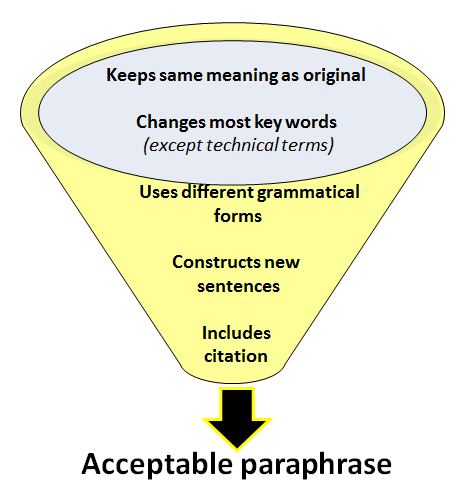Text-level paraphrasing
Text-level paraphrasing
So far, we have looked at individual techniques as first steps to paraphrasing. At the text-level, we are creating paragraphs and the challenge here is to use more than one technique at the same time to construct an acceptable paraphrase.
Text-level paraphrasing is also concerned with ensuring coherence and unity in the paragraph with the use of effective transitions or markers, and other cohesive devices.
The techniques explored so far are:
- synonyms and antonyms
- word definitions
- word form changes
- clause order changes
- sentence type changes
- citation inclusion
![]() Read the opening statements of two separate reports of a shooting in France in May. You will see that the information is basically the same, but the reporter of The China Post has employed different grammatical forms and sentence structures to report the same incident. Answer the questions to find out what these techniques are.
Read the opening statements of two separate reports of a shooting in France in May. You will see that the information is basically the same, but the reporter of The China Post has employed different grammatical forms and sentence structures to report the same incident. Answer the questions to find out what these techniques are.
1. Hundreds of police blanketed southern France on Tuesday, searching for a gunman - possibly a racist, anti-Semitic serial killer - who killed four people at a Jewish school and may have filmed his attack.
Authorities suspect the same killer was behind attacks last week on French paratroopers of North African and French Caribbean origin, that left three dead and one seriously wounded.
(Reported in - www.breakingnews.ie/world/thousands-of-police-search-for=cold-cruel-french-school-killer-544233.html)
2. Thousands of French police were today hunting the Jewish school killer described by the country's president as a "monster on the loose".
It emerged that the gunman may have filmed his attack, as he shot dead a teacher, his two young sons and a little girl.
The same killer is also suspected of murdering three French soldiers of North African and Caribbean in two separate attacks last week.
(Reported in The China Post March 21.2012)
Text-level paraphrase analysis
The information in the two reports is basically the same, but The China Post reporter (Report (2) has employed some clever paraphrasing techniques:
a) What word-level changes has the writer of The China Post made?
b) Can you give at least an example of a clause order change at the sentence level?
c) Can you given an example of a sentence type change?
d) What terms have not been changed? Why not?
e) What other changes do you notice?
1 Synonyms:
searching for hunting
killer for gunman
killed for shot dead
French police for police ...southern France
soldiers for paratroopers
it emerged that for suspect
Word definitions: Jewish killer for racist, anti-semitic serial killer
2 Clause order (active to passive): The same killer is also suspected (passive voice) for Authorities suspect the same killer' (active voice)
3 Breaks up sentences: It emerged that the gunman may have filmed his attack, as...(This detail was part of one sentence in the first report after 'and')
4 Proper names or class names, e.g. police, North African, Caribbean, Jewish, French
5 a) uses a quotation "monster on the loose" and referred to authority (the country's president);
b) provides details (a teacher, his two sons, a little girl for four people)
![]() Text-level paraphrasing: combining strategies
Text-level paraphrasing: combining strategies
Step 1: Read and understand the text Original text
Language is the main means of communication between peoples. But so many different languages have developed that language has often been a barrier, rather than an aid to understanding among peoples. For many years, people have dreamed of setting up an international universal language which all people could speak and understand. The arguments in favour of a universal language are simple and obvious. If all peoples spoke the same tongue, cultural and economic ties might be closer, and goodwill might increase between countries. (Kispert, 2004, p. 128)
Text source: Oshima, A. & Hogue, A. (2006). Writing academic English (4th ed.). N.Y.: Pearson Education, Inc. | Step 2: Make notes (think of synonyms and other words) 1)language - mainly for communication/ contact/ interaction/ connections between people/ humans 2)many languages- making understanding increasingly more difficult--need for a common global language 3)clear advantages:will promote better cultural + trade relations, peace + harmony among nations
|
Step 3: Construct sentences from the notes Click on the highlighted parts to find out what paraphrasing techniques were used in combination to create the following paraphrase: Humans communicate through language, but over the years, many new languages have appeared. As a result, people around the world have found it increasingly difficult to understand one another. The most ideal solution, it would seem, is to establish a global language that everyone could easily use. Kispert (2004) argues that a common global language has clear advantages because it would not only bring about better harmony and understanding but also build more trade relations among diverse cultures and nations. |
![]() Unacceptable paraphrase
Unacceptable paraphrase

An acceptable paraphrase must satisfy a range of critieria (review this from the figure on the left, shown earlier in the module).
Read another paraphrase of the text. Then, from the given options, select those that might explain why it is unacceptable.
| Language is the principal means of communication between peoples. However, because there are many languages, language itself has frequently been a barrier rather than an aid to understanding among the world population. For many years, people have envisioned a common universal language that everyone in the world could communicate in. The reasons for having a universal language are clearly understandable. If all countries spoke the same tongue, they would undoubtedly become closer culturally and economically. It would probably also create good will among nations. (Kispert, 2009) |





